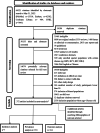Global prevalence, incidence, and outcomes of alcohol related liver diseases: a systematic review and meta-analysis
- PMID: 37170239
- PMCID: PMC10173666
- DOI: 10.1186/s12889-023-15749-x
Global prevalence, incidence, and outcomes of alcohol related liver diseases: a systematic review and meta-analysis
Erratum in
-
Correction: Global prevalence, incidence, and outcomes of alcohol related liver diseases: a systematic review and meta-analysis.BMC Public Health. 2023 Jul 18;23(1):1380. doi: 10.1186/s12889-023-15986-0. BMC Public Health. 2023. PMID: 37464293 Free PMC article. No abstract available.
Abstract
Background: Alcohol related liver disease (ARLD) is one of the major chronic liver diseases worldwide. This review aimed to describe the global prevalence, incidence, and outcomes of ARLD.
Methods: Medline, Embase, The Cochrane Library, and China National Knowledge Infrastructure (CNKI) were searched from inception to May 31, 2022. The language was restricted to English or Chinese. According to the criteria, articles describing the basic characteristics of the population were selected. Two reviewers extracted the data independently.
Results: A total of 372 studies were identified: 353 were used for prevalence analysis, 7 were used for incidence analysis, and 114 were used to for outcome analysis. The prevalence of ARLD worldwide was 4.8%. The prevalence in males was 2.9%, which was higher than female (0.5%). Among the ethnic groups, the percentage was highest in Caucasians (68.9%). Alcoholic liver cirrhosis comprised the highest proportion in the disease spectrum of ARLD at 32.9%. The prevalence of ascites in ARLD population was highest (25.1%). The ARLD population who drinking for > 20 years accounted for 54.8%, and the average daily alcohol intake was 146.6 g/d. About 59.5% of ARLD patients were current or former smokers, and 18.7% were complicated with hepatitis virus infection. The incidence was 0.208/1000 person-years. The overall mortality was 23.9%, and the liver-related mortality was 21.6%.
Conclusion: The global prevalence of ARLD was 4.8% and was affected by sex, region, drinking years, and other factors. Therefore, removing the factors causing a high disease prevalence is an urgent requisite.
Trial registration: PROSPERO Nr: CRD42021286192.
Keywords: Alcohol related liver diseases; Epidemiology; Prevalence.
© 2023. The Author(s).
Conflict of interest statement
The authors declare no competing interests.
Figures



References
-
- Global status report on alcohol and health 2018 [https://www.who.int/substance_abuse/publications/global_alcohol_report].
-
- Xiao J, Wang F, Wong NK, He J, Zhang R, Sun R, Xu Y, Liu Y, Li W, Koike K, et al. Global liver disease burdens and research trends: analysis from a Chinese perspective. J Hepatol. 2019;71(1):212–221. - PubMed
Publication types
MeSH terms
LinkOut - more resources
Full Text Sources
Medical

